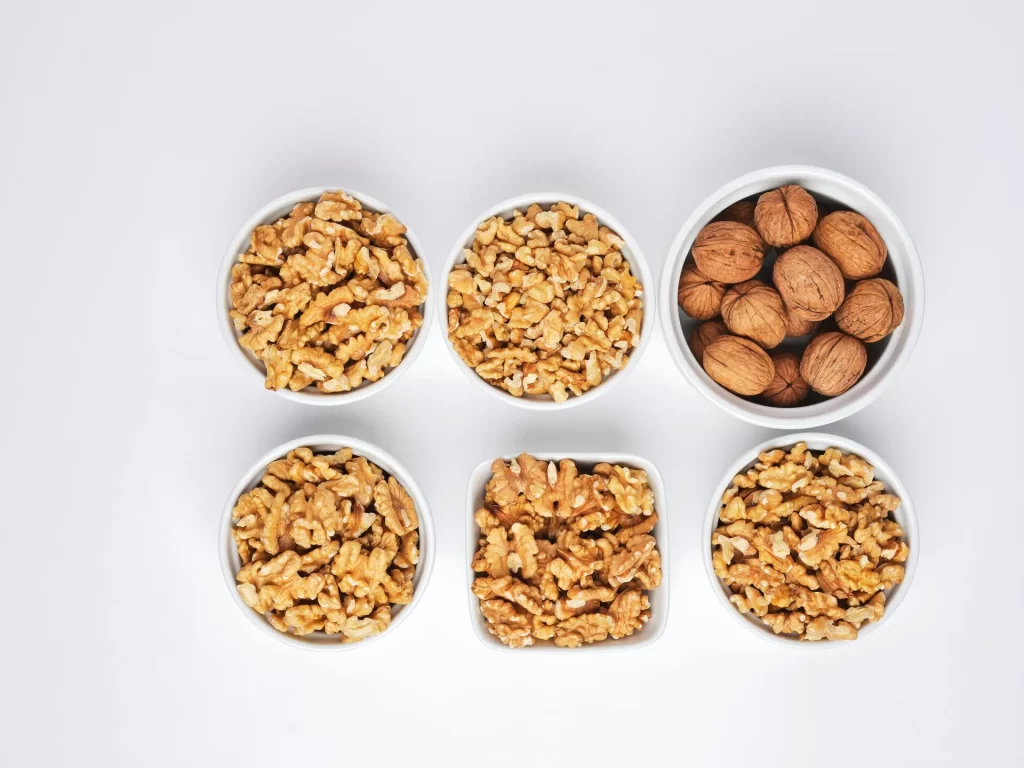No products in the cart.
Uncategorized
Walnuts Welcomes Newly Proposed FDA Health Claim

As one of the top walnut suppliers in the world, ofi welcomed the latest news released by the US Food and Drug Administration (FDA), proposing a new definition of “healthy,” that would allow walnuts to meet the criteria. While the proposed rule is still subject to change, this is promising news for companies who sell walnuts as a snack, or as an added ingredient in their final product, as consumers are increasingly aware of making healthier choices in their eating habits. Walnuts provide 4g of protein and 2g of fiber per 1-ounce serving. With 2.5 grams of the omega-3 fatty acid alpha-linolenic acid, or ALA, they’re also the only nut to provide a rich source of this key plant-based nutrient¹,².
The potential health benefits of walnuts have been well documented in the scientific literature, including their possible role in supporting cognitive health and type 2 diabetes management ³,⁴. Research has also shown that walnuts may support heart health, with studies finding walnut consumption associated with decreases in blood pressure and improved cholesterol levels ²,⁵. Supportive, but not conclusive, research also shows that eating 1.5 ounces of walnuts per day may reduce the risk of coronary heart disease when eaten as part of a low-saturated-fat and low-cholesterol diet, and not resulting in increased caloric intake. Supportive but not conclusive research shows that eating 1.5 ounces per day of walnuts, as part of a low saturated fat and low cholesterol diet and not resulting in increased caloric intake.
ofi has walnut grower networks in both California and Chile. We currently have over 300 acres of walnut orchards in our California operations. What sets ofi apart from the rest? Along with machine-cracking for culinary and ingredient usage, our processing facilities also have the capability to hand-crack our walnuts for the snack-grade levels. Our processing facilities includes pre-cleaning, hulling and then hand- or machine-cracking. We offer various grades of walnuts, from Extra Light Fancy Halves to Baker Pieces.
While ofi primarily offers chandler variety, we also supply other non-chandler varieties. Chandler varieties are better suited for snacking, while the non-chandler varieties that generate less halves and are darker in color function better as an ingredient.
The exciting news from the FDA could help drive consumption of walnuts beyond just a snacking level. While the health halo lives in these little kernels, the ability to now provide that extra punch of health claims to existing products by adding walnuts as an ingredient poses a meaningful change for the snack bar, baked goods, and even plant-based meat industry…
…you read that right: walnut-based meats! We sat down with ofi’s Chef Daniel Espinoza for a Q&A to learn more about his use of walnuts in plant-based meats.
Chef Daniel Espinoza
Corporate Chef, ofi
In May 2022, Chef Espinoza and his team of chefs working in product and application development at ofi won People’s Choice at the Culinary Fight Club in Chicago. They advanced to the national Culinary Fight Fest in October, 2022, where his team won the grand prize. Chef Espinoza previously won the prestigous pork competition “Cochon 555,” crowning him the prince of pork in Chicago. In 2017, he was nominated as a finalist for “eater young guns” and in 2016, he participated in “Top Chef Mexico,” during which he tested his Chicano cooking style to high praise by finishing in the top four out of 15 competitors.
Check out Chef Espinoza’s full biography.

Q: What are some of the unique ways you have personally used nuts, and walnuts specifically, as a plant-based meat?
A: One of my personal favorite ways I use walnuts is as an alternative to panko breadcrumbs. I take crushed walnuts, or walnut meal, and add herbaceous notes from dried dill and parsley, add some ground onion, garlic, and chile guajillo. I love coating fish, such as trout, in the walnut breading or meal for a great nutty crispy crust. I use walnuts a lot when making soups, such as sweet potato soup. There are times where you do not want to use dairy, so instead of using a thickening cream, or adding gluten or starches, I use toasted walnuts or other nuts as a thickening agent, and I also get that nutty toasty note.
My all-time favorite use of walnuts is for walnut chorizo. I make this with walnut meal, a chorizo spice blend, vinegar, and cocoa butter. When I make chorizo quesadillas, I often surprise long-time chorizo lovers when they find out there is no pork or beef. I emulsify the ingredients in a food processor and allow it to refrigerate.
Chef’s Tip: Swap out the spice blend for taco seasoning and use the walnut-based meat in tacos.
Q: What types of spices enhance the flavor or work best when using nuts as a plant-based meat?
A: Spices that bring a presence where their attributes shine through the richness of nuts such as cayenne, habanero, jalapeno are chiles that come to mind instantly. Warm spices play a key role as well to the likes of cassia, nutmeg, allspice, and of course, onion and garlic for those umami notes that keep us wanting more. Be sure to check out ofi‘s extensive spice selection.

Q: What are some of the challenges when using walnuts to make plant-based meat?
A: One of the challenges is realizing at the end of the day, we are dealing with nuts, meaning of course it may not have the same high heat point as a piece of meat. Consistency is a challenge when you seek consistent end results.
Prep work in comparison to working with actual meat is a positive. For example, the walnuts in our walnut chorizo are ambient. When dealing with proteins you have a short window before it begins to reach a danger zone temperature, or before it is even cooked you need to apply such marination process or prep work that comes with it from breaking down and portioning a piece of meat.
Q: What are the innovative ways do you foresee walnuts being used in recipes, espeically with the new proposed health claim released by the FDA?
A: I see nut flours coming into play where they normally do not get as much attention, such as Gen Z snacks and a “healthy” junk food approach. I also anticipate walnuts being used in the beverage industry, as we have seen a health and wellness approach to cocktails/mocktails. We’ve already seen ofi’s Senior Beverage Scientist Candace Smith-Lee discuss a few nut-based milks that she uses in her spirit-free cocktails!
With this exciting news, we anticipate consumers getting creative in their walnut consumption, be it through traditional snacking or incorporated into new and existing products.
Check out additional recipes where walnuts are incorporated.
Interested in learning more about ofi walnuts? Check out our extensive selection of walnuts available through our website or schedule a call with a nuts industry expert.
References:
- S. Department of Agriculture, Agricultural Research Service. FoodData Central, 2019. fdc.nal.usda.gov. https://fdc.nal.usda.gov/fdc-app.html#/food-details/170187/nutrients
- Ros, E. (2015). Nuts and CVD. British Journal of Nutrition, 113(S2), S111-S120. doi:10.1017/s0007114514003924
- Chauhan, A., & Chauhan, V. (2020). Beneficial effects of walnuts on cognition and Brain Health. Nutrients, 12(2), 550. doi:10.3390/nu12020550
- Tapsell, L. C., Batterham, M. J., Teuss, G., Tan, S., Dalton, S., Quick, C. J., . . . Charlton, K. E. (2009). Long-term effects of increased dietary polyunsaturated fat from walnuts on metabolic parameters in type II diabetes. European Journal of Clinical Nutrition, 63(8), 1008-1015. doi:10.1038/ejcn.2009.19
- Tapsell, L. C., Gillen, L. J., Patch, C. S., Batterham, M., Owen, A., Baré, M., & Kennedy, M. (2004). Including walnuts in a low-fat/modified-fat diet improves HDL cholesterol-to-total cholesterol ratios in patients with type 2 diabetes. Diabetes Care, 27(12), 2777-2783. doi:10.2337/diacare.27.12.2777

